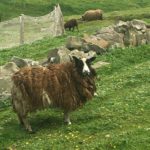Shetland Sheep
Shetland Sheep

Foula prides itself on its particular Shetland sheep breed. This breed has been cut off from the mainland and therefore these Foula Shetland sheep are a purer strain. They are hardy and resilient to the harsh, long, cold winters, due entirely to their fleeces. The Shetland fleece is double layered, it has an under layer and an outer layer. Each wool strand or ‘staple’ is very long and has a high crimp count (the waviness of the fibre, which helps to trap air) prevalent in a superior wool. It also has great wick ability, its capacity to absorb water, keeping the sheep dry and warm during torrential rain
Foula sheep are notably multi coloured. There are 32 different colour/pattern combinations recognised by the Shetland Sheep Society with names such as Yulet, meaning having colour around the eyes that is different from the remainder of the body and Katmollet, having light coloured nose and jaws. The list goes on…Lynn Robertson, a local crofter, told me about ‘Imie’ and ‘Sweep,’ both names to describe sheep with a prevalent characteristic such as a tear drop under the sheep’s eye or a sheep with pale flanks. All of these colour/pattern combinations have come about from this island gene pool. As a result of all these differences the Foula sheep produce wool in a wide range of natural colours
Coming from Wales, I was intrigued by the enormous number of sheep I noticed grazing on Foula and wanted to know what they were being used for and what their value was. It was a fascinating piece of research that led me to interview three islanders. The first being Magnus Holbourn, who told me that when he inherited his flock of sheep from his father, he had to make a hard decision to do things ‘differently’ from the past. He decided to reduce his flock of sheep and to start concentrating on producing a quality fleece that is easier to process. This has led to an exciting new island initiative called The Foula Wool Project. Magnus now buys the best island fleeces and spends the winter sorting the fleeces before shipping them to Yorkshire to be processed and spun. The wool is then sent back to the island and sold directly via their website Foula Wool. This adds value and a brand to this top-grade wool, as well as giving recognition to the island’s unique sheep gene pool
The second is concerning meat, as all sheep has to be sold on the mainland and with this protected gene pool, unsold sheep cannot be returned the island, in case of contamination. As a result unscrupulous bidders were forcing the prices down, knowing that the Foula sheep had to be sold. How unfair is that? Today though, since Covid, there is much more on line bidding cutting out this unfair practice and I was told that, with the uncertainty of Brexit now over, sheep are making better prices
My last question was why there were so many sheep on the island? This was answered by Sheila Gear of Foula Heritage, during a two hour interview in which she patiently answered all my questions, never hesitating, even though she has probably done this a million times before. Finally Sheila admitted that there were still a lot of sheep on the island, although only about half of what there were in the 1980s, because the islanders just love their sheep and that is a good enough reason for me, as they are really delightful, Thank you Sheila, thank you Lynn and thank you Magnus for giving me your time and experience